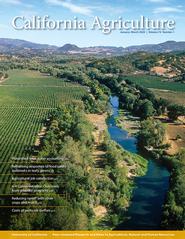All Issues

View of the Russian River near Hopland, Mendocino County. A recent UC Cooperative Extension research project in the upper Russian River and Navarro River watersheds demonstrates how water use accounting can support the development of solutions for managing limited water supplies. Photo by George Rose.
Volume 74, Number 1
News and opinion
Four major foodborne illness outbreaks in 3 years have led to stricter requirements for leafy greens growers that may satisfy corporate buyers and reassure the public, but also highlight a serious need for more food safety research.
Recent articles from the Agricultural Experiment Station campuses and UC ANR's county offices, institutes and research and extension centers.
The California Naturalist program, which links the state's residents with their natural surroundings, is making strides toward addressing its diversity challenges.





